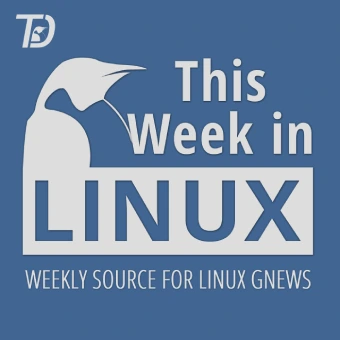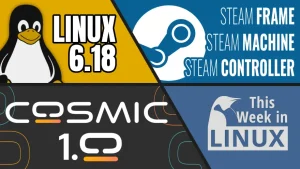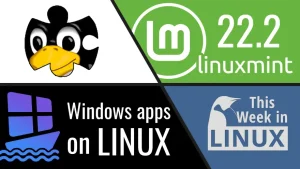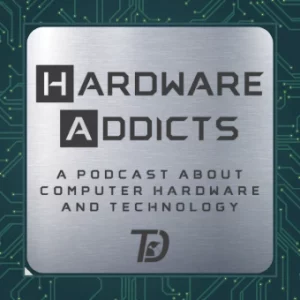This week in Linux, we have a huge milestone to celebrate with Linux hitting the coveted 5% market share for desktops in the US market. Then we got a few gaming topics to cover including one about game preservation and anti-cheats. Then we are going to take a look at a project to keep X11 window managers around for good. Later in the show we’ll check out some new releases including a lightweight window manager called IceWM. All of this and more on This Week in Linux, the weekly news show that keeps you up to date with what’s going on in the Linux and Open Source world. Now let’s jump right into Your Source for Linux GNews!
Support the Show
Become a Patron = tuxdigital.com/membership
Store = tuxdigital.com/store
Chapters:
00:00 Intro
00:48 Linux Hits 5% US Desktop Market Share
04:14 Stop Killing Games Initiative
11:11 Wayback: Experimental Layer for X11 Desktops on Wayland
15:39 Sandfly Security, agentless Linux security
17:34 IceWM 3.8 Window Manager Released
19:05 Anti-Cheat on Linux: THE FINALS & Broken Arrow
22:26 digiKam 8.7 Released
24:05 ProtonPlus to manage Proton layers for Gaming
25:53 Outro
Links:
- Linux Hits 5% US Desktop Market Share
- Stop Killing Games Initiative
- Wayback: Experimental Layer for X11 Desktops on Wayland
- Sandfly Security, agentless Linux security [ad]
- IceWM 3.8 Window Manager Released
- Anti-Cheat on Linux: THE FINALS & Broken Arrow
- digiKam 8.7 Released
- ProtonPlus to manage Proton layers for Gaming
- Support the show
Transcript-View full transcript
View full transcript
Michael:
[0:00] This week in Linux, we have a huge milestone to celebrate with Linux hitting the coveted 5% market share for desktops in the US market. Then we got a few gaming topics to cover, including one about game preservation and another one about anti-cheats. Then we’re going to take a look at a project to keep X11 window managers around for good. And then later in the show, we’re going to check out some new releases, including a lightweight window manager called IceWM. All of this and more on This Week in Linux, the weekly news show that keeps you up to date with what’s going on in the Linux and open source world. Now let’s jump right into your source for Linux. Good news.
Michael:
[0:44] This episode of Twill is sponsored by Sandfly Security. More on them later. Linux has crossed a huge threshold in the US.
Michael:
[0:51] StatCounter is reporting that Linux now holds more than 5% of the desktop market. That’s right, 5%. Of course, for now, Windows remains the dominant percentage, but that is shrinking, and at this point, it’s shrinking quickly.
Michael:
[1:04] Apple shares sit around about 24%, but this 5% is likely not accurate. It’s probably much more. The real Linux footprint is likely higher because of many factors. For example, all the privacy-minded people who are blocking trackers, the people who use the blending techniques so they don’t technically block the trackers, but they trick the trackers and stuff like that. And there’s also the 4.76% of the unknown bucket, which likely includes some Linux users as well. And of course, the Chrome OS version, which has a 2.71% share, which is built on the Linux kernel. So you could count that if you wanted to. Not exactly the same thing, but still you could count it if you wanted to. And what could be the drivers of this growth? Well, I think that Valve making Linux gaming is a solid alternative. And the Steam Deck itself has to be part of it because once gamers see the magic of Proton on the Steam Deck, I’m sure many people installed Linux on their computers. There’s also the growing frustration with Windows, like Windows 10, the end of life of it, and the Windows 11 hardware demands, and also the Windows 11 Windows Recall, the stupid, insanely stupid Windows Recall user tracking is also probably part of it. All of this is happening when Linux is at a point where it is a very easy to use system by pretty much anyone these days. Of course, it’s not for everyone.
Michael:
[2:28] Just like no OS is for everyone, but it has become so much easier these days. The momentum of Linux on the desktop is climbing exponentially as well. It took eight years to climb from 1% to 2%, and a little over two years to go from 2% to 3%, and then 3% to 4% was less than a year. And then again, less than a year to go from 4% to 5%. That’s exponential acceleration in my opinion. Now, I know there are some people out there that want Linux to stay small.
Michael:
[3:02] I hope you don’t get what you want because they want it to stay small in like an elite club where it’s cool to use the outskirts type of thing, the outsider stuff. And I hope they don’t get that because with more users, we have more developers that we can attract. And then that means there’s more support for various different hardware. There’s more apps that are being brought to the platform and just a better experience overall for everyone. So I hope that’s what happened. The positive feedback loop for Linux that I’ve been wanting for a very long time. And I hope that keeps going. To all the companies out there wondering if you should make your hardware support Linux or your application support Linux, it has never been a better time. And with this momentum, it’s becoming a mistake not to do it. So get on it. And just a quick note, I’d like to tell you that if you’re checking out my podcast, We had a prediction episode at the beginning of the year, and I said that it was going to get to 5%.
Michael:
[4:00] And it did. So I predicted the 5% growth, and it totally did it. So checkmark for me on the predictions. I just wanted to tell you, I’m proud of the fact that I got it right.
Michael:
[4:13] Anyway, have you ever bought a video game only to have it become completely unplayable just later down the line? Well, you’re not alone. This is a growing problem, but there is a campaign that is trying to stop it. We’re going to talk about that because there’s some really good news about it. Traditionally, video games were sold as physical products, like a book or a movie. You bought the game and it was yours to play for as much as you wanted to. Provided that your machine that you built it on, like a console or a PC or whatever you played it on, as long as that kept running, you’d be able to play it forever, theoretically. But increasingly, games require an internet connection to function, even for single player games. This means that the publisher, not the player, has control over whether or not the game is even playable. And last year, Ubisoft shut down the servers for the game called The Crew. So even if you bought the game, you can’t play it anymore. In fact, some people have reported that it’s being removed from their library entirely, as in they’re not even allowed to see it in their library. So the crew had millions of players. It wasn’t that old of a game either. Sadly, this isn’t the first time this has happened, and it likely won’t be the last because this has become a growing trend, especially among AAA titles.
Michael:
[5:20] Thankfully, we have someone trying to do something about it. Ross Scott from the Accursed Farms YouTube channel has a campaign called Stop Killing Games, and this is to push governments to take action. This campaign argues that shutting down games like The Crew is unfair to consumers and hurts the preservation of video games as a whole. This initiative started efforts in multiple regions around the world with the EU and the UK efforts probably being the most important. Now that you know what Stop Killing Games is.
Michael:
[5:51] I have some awesome news. The Stop Killing Games petition has scorched past the 1 million subsignatures that it needed to get attention from the European Commission. And it’s actually in a very quick recovery. But the organizer, Ross Scott, says that the headline number might not be real. So the final sprint is still on. Just a couple of weeks ago, it looked very bleak for the project. But recently, it had a resurgence due to some new information coming out about the initiative. Really, it was an accidentally fueled by another YouTuber who kind of caused some drama in the whole situation. The quick overview of that drama was that the streamer Pirate Software was accused of spreading misinformation about the initiative. And as a last ditch effort, Ross decided to just address the claims made by Pirate Software in a video. And from there, it spiked signups by tens of thousands. There’s a lot of people making videos about this drama. So if you’d like to know more about that stuff, you can go check out those videos. But the gist of the drama is that Pirate Software misinterpreted what the initiative was about and was pretty aggressive about his opinion. And when the details were clarified, well, the drama escalated.
Michael:
[7:00] Overall, this might have helped the initiative to get where they wanted to go, but I’m sure they would have probably preferred to avoid any drama. All right, so what does hitting 1 million signatures do? Well, it obligates the European Commission to respond, but there’s a potential issue because some of the signatures might be fake or they might be voided. For example, typos void signatures automatically. They want to get to a 40% safety buffer to offset the issue because apparently there’s a percentage of people.
Michael:
[7:29] Statistically on these kinds of things, can’t write their own name properly. And reports say that EU officials routinely strike 10% to 20% of entries during the verification process of these kinds of campaigns. So the team is targeting 1.4 million to hopefully avoid any of those kinds of invalidations. The deadline to get a signature is coming up very soon. So if you want it to count, the count locks on July 31st. Another issue is that Ross said that the surge of spoofed and botted names has him in a kind of a fog of sorts. He also clarifies that something is very important is that it’s not a change.org petition. If you do this and you sign it and it’s not real, it’s actually a crime. So it appears the EU also takes this very seriously and fake entries risk being handed to Europol, Interpol, or the FBI once the audit starts. So if you’re not in the EU, do not sign the initiative. Once the campaign ends, the legit signatures will remain valid, but the illusion of success could actually stall momentum. So again, if you haven’t signed and want to and are in a country that is valid to sign it, then do that because we shouldn’t assume that hitting the first threshold will be enough because it might not be.
Michael:
[8:50] Also, there are some tech hiccups for some people in Italy and also in Belgium reporting that digital ID logins were failing. So the alternative is to use manual PDF form or just try later.
Michael:
[9:03] Apparently, both countries are aware of the issue and are addressing it. So you could just, you know, try later or you could do the manual way. And if you want to do the manual way, there’s a step by step instructions guide on the campaign website. Also across the pond, as they say, the UK petition blew past the 100,000 threshold and it sits about 154,000, but similar concerns exist for that campaign too. So extra names are always welcome or padding. Also, it looks like someone is making a rogue cryptocurrency for this, like a stop killing games cryptocurrency. That’s not a real one. It’s not official. And it’s clearly just trying to make a quick buck on the momentum. So be sure to avoid that. But anyway, if you’re an EU citizen, sign your name at StopKillingGames.com if you agree with the initiative. I think this is really good because the idea that a company can just basically perpetually rent something…
Michael:
[9:57] And then take it away at any point because they call it buying they’re saying that you’re buying it but all of a sudden they can just pull it away at any time for basically no reason some came companies like i’m pretty sure blizzard was one of them that had a note in their terms of service that says they can remove access from you to for no reason at all and that’s uh that’s a bit sketch so either tell me i’m not buying it i’m renting it or let me actually have it when i buy it it’s also important to note that they’re not saying that this initiative is not saying that you have to have the games working exactly as they were for the entire period like forever because that’s not really practical because if it’s an online service game then they wouldn’t really they would have to have the servers exist forever and that’s just not that’s not practical at all so it’s just a minimum functional state is what they’re looking for and i think that’s totally reasonable so if you are in the eu and you want to sign it be sure to do so before july 31st If you’re in the UK, you can add your name to the Parliament petition. And if you aren’t in the EU or the UK, don’t sign, because that could be bad. Just don’t. With that said, for those in relevant countries, links below.
Michael:
[11:08] Let’s keep games we paid for playable. Eventually, Linux users will be saying something like, this is the way, Lent.
Michael:
[11:17] But right now, some people are not all that excited for the forthcoming Wayland future. So I’m excited to tell you about a brand new project called Wayback, because it is basically going to be a lifeline for X11 fans because it plans to make it possible to run classic X11 desktops on Wayland. Unmodified. That’s the important part right there. So Wayback is a stub compositor that boots a full-screen, rootful X-Wayland session, letting any X-centric window manager thinking it’s still talking to X. For those who are new to the Linux platform, you might be thinking, wait, what is X11? And what is Wayland? Well, the TLDR of all that is that both of these projects make it possible to render software and desktops to your screen. They are what’s known as a display server.
Michael:
[12:05] For new users, you really have no reason to care about any of this. This is very under the hood type of stuff. If you don’t want to care, you don’t have to care. Not that important. Just use whatever you’re using and enjoy. So just enjoy your Linux experience and ignore this stuff. However, if you do want to know more about that, then stick around. Otherwise, check out one of the other topics that we have on the show because there’s chapters that you can quickly jump to around for all the different stuff. So do that. The developer of Wayback describes the project as an experimental X compatibility layer, which allows for running full X desktop environments using Wayland components. So far, early tests report that LXDE and FVWM launched successfully through Wayback. The way it works is that Wayback supplies just enough Wayland to host X Wayland as a full screen and then hands the control over to the X11 window manager. And what makes this a game changer is that it doesn’t need to do any rewrites for the compositors.
Michael:
[13:07] Essentially, this bypasses the classic chicken and the egg problem, whereas an X11 window manager can’t act as a Wayland compositor, but they can use this. There are other efforts to make classic window managers work on Wayland, but those are usually kind of like full rewrites with the essence of the original window manager intact, but not the full thing. It’s more of like a brand new project, like i3 and Sway, for example. Wayback could make it possible to keep the original window manager intact without modification for maximum nostalgia for those who want to keep their legacy window managers around.
Michael:
[13:43] Connell, the lead developer of Wayback, hopes to tag a production-ready release for Alpine Linux sometime next year, maybe in May for the 3.24 release or in November for the 3.25 release. And there are plans to try to make way back the default X layer for Alpine Linux at that time.
Michael:
[14:03] Of course, expectations should be kept in check for now as it is an experimental project and the developer said on Mastodon that it is very likely that it is going to do things which makes you mad at this point. But this is great news for people wanting to keep X11 window managers around and looks very promising with a goal of just a year to get to that polished stage. Maybe if more developers jump on the project they could get it all done even faster. That’s just hopeful thinking on my part though, but I’m still hoping that does happen. There are some discussions over performance and security of a rootful X-Wayland session to make this work, but theoretically, this could be an improvement to the current issues of X in general. And since major distros are dropping support for X11 in the coming months, I think this is an outstanding effort to keep these things running for those that want it to. The end goal seems to be replacing the dependency of the old X server and letting Wayback be the path forward to keep X-only software still available to users. If there’s a classic X11 desktop that you love and dread the Wayland endgame, then maybe keep an eye on this project for Wayback. And if you have the means to jump into the GitHub repo, maybe give it a helping hand to get there sooner. And if you’d like to learn more about this whole thing, we’re actually going to cover it in the next episode of the podcast.
Michael:
[15:25] About it there and we have a much more in-depth discussion i think this is very cool and there’s a lot of potential for it but it is experimental so keep that in mind you might you might not want to play with it just yet but i am so excited
Michael:
[15:37] for it and i just can’t hide it as linux users we know what’s up security is non-negotiable but with threats getting smarter your security tools need to keep up without dragging your system down traditional agents they slow you down they leave blind spots.
Michael:
[15:52] It’s time for a smarter approach. And that’s why This Week in Linux is proud to be sponsored by Sandfly Security, the revolutionary agentless platform designed for Linux. Sandfly doesn’t just detect and respond. It revolutionizes security with SSH key tracking, password auditing, and drift detection, covering threats from every angle. Whether your systems are in the cloud, on-premises, or in embedded devices, Sandfly ensures they’re all secure, without the headaches of agent-based solutions. If your company is interested in transforming your security strategy, Sandfly is offering free trials to show off what it can do for your business. So if you want to check that out, go to thisweekinlinux.com/Sandfly. Listen to what Selinda Lakamgi of Tate Communications has to say. Sandfly addresses a serious security gap in the industry, intrusion detection on Linux platforms. The best part of Sandfly is its agentless nature, making it a versatile application for any Linux environment. So experience security that’s not just effective, but gives you peace of mind. No agents, no downtime, just cutting edge protection. Dive into the future of Linux security at thisweekinlinux.com/sandfly. That’s thisweekinlinux.com/S-A-N-D-F-L-Y. And see how Sandfly can transform your security strategy. Also, if you’re as fascinated by cybersecurity as much as I am, then go check out the interview we had on Destination Linux with the CEO of Sandfly, who has an awesome story about how he got into Linux.
Michael:
[17:14] Security, and even some stuff about DEF CON. Check it out at destinationlinux.net/409 for that interview. Plus, if you want to save some money on the home edition, you can use the discount code destination50 to get 50% off the home lab edition.
Michael:
[17:30] So go to thisweekinlinux.com/sandfly to get started. In the previous topic, we were speaking of X11 window managers and the lightweight legend IceWM recently released a new version with IceWM 3.8, and it brings snappier theme menus, leaner resource graphs, and a smoother ride for vintage hardware. Let’s talk about what’s new in this version. This new version has optimized themes menu, making it load much faster. They also made a change so that the minimize button now appears as a preview icon, making it easier to visualize theme changes before applying them. They also have expanded their help menu with additional man pages to improve the documentation. ISWM is all about lightweight value, which of course includes performance. And they have improved the performance further by doing some work to reduce CPU usage by fine tuning the CPU and mem graphs. They’ve also added Serbian as a new translation and updated the Slovenian translation. Obviously, this is a gesture for Nikola Jokic because he got robbed as the MVP in the NBA. So of course, that’s why they added Serbian. And with Slovenian, of course, they did updates because it’s a good luck to Luka Doncic on the Lakers.
Michael:
[18:43] No, wait, I’m getting a note from my producer that no, that has absolutely nothing to do with the NBA.
Michael:
[18:52] So thanks to the phantom producer and my non-existent earpiece.
Michael:
[18:57] Anyway, if you have a super old computer that you want to bring back from the
Michael:
[19:01] being unalived, give IceWM a look over. Links in the show notes. One of the biggest questions I get in my comments and in our Discord server and on our forum is related to gaming on Linux specifically, as you would imagine, and how well various games work on the platform. For the most part, gaming on Linux is great, but sometimes there are some news stories that I bring on the show related to anti-cheat and they typically bum me out. But that’s not happening this week. We got some news from two game developers that are adding anti-cheat to their games, but are not wanting to get rid of Linux gamers, which is awesome. So Embark Studios recently revealed their game, The Finals, is switching to a kernel-level anti-cheat, but they insist Steam Deck gamers and desktop Linux players won’t be left behind. At first, a lot of people were worried because there was a note in their patch notes that kind of had the details buried a little bit about a kernel-level anti-cheat being added in a gradual rollout over the coming months, alongside some machine learning detection tweaks, which they intended to significantly raise the bar for the cheat makers. And a lot of people were worried that that meant that Linux was going away. For those that don’t know, kernel-level anti-cheats are basically the deepest an anti-cheat can go and usually mean the end of Linux support because, well, the Linux platform doesn’t let companies control your computer. In Linux, the user is in control, not the company.
Michael:
[20:27] Kernel level anti-cheats simply can’t work on Linux because that would be a violation of user control. And so they typically just break the Linux support instead. Technically speaking, they can, they kind of can work, but with, you know, like with Proton, because there’s the Proton kernel or the wine kernel that’s inside of Proton, but it’s, it’s a bit more complicated. And anyway, I covered this in a few videos on my channel. If you want to know more about it, you can check those out. I’ll have those linked in the show notes. After the initial concerns were brought up by the community, the developers of the finals followed up within the next day to say that they were what they’re going to be doing is they say they will do their utmost best to keep Linux functionality and testing on Steam Deck is part of the plan. So hopefully this doesn’t become yet another game that abandons Linux claiming Linux has the problem. So far, so good though, which is great to hear. Also, there’s a newcomer to the RTS scene called Broken Arrow, and they’re creating their own in-house anti-cheat. And that typically means a bad thing. Like, for example, how Vanguard with Valorant and League of Legends breaks support for Linux because they have an in-house anti-cheat. But that’s not what Broken Arrow’s doing. They too pledge that it will not block Linux or SteamOS.
Michael:
[21:45] In fact, it is a bespoke user agent anti-cheat with no kernel modules planned, And so that’s great as well. So you can see that some developers are actually realizing that you don’t have to break games on Linux in order to have an anti-cheat. So that’s awesome. It is actually, it is possible, in fact, to have a game using anti-cheat without blocking Linux gamers. And here are two examples, as well as the many that already exist. So to all the developers who are blocking Linux because of just basically lazy development, and I guess, shame on you.
Michael:
[22:22] And to Broken Arrow team and to the finals team, thank you very much. The open source photo management powerhouse digiKam recently released a new version with digiKam 8.7. This release brings some AI into the mix with some very dope context-aware auto-rotation.
Michael:
[22:39] Plus smarter face recognition and a bunch of bug fixes. The biggest feature that steals the show here is the new Batch-Queue plugin that uses deep learning content analysis to detect orientation and pivot each shot automatically, basically having AI auto-rotation. This is great for scanning mixed angle film photos and a bunch of stuff. Very cool feature. With also this new release, we have a new face recognition features.
Michael:
[23:06] digiKam now can auto-launch a background scan whenever new faces are tagged and remembers rejected matches to offer the next best suggestion. This basically gives a user a streamlined tagging process for pros juggling thousands of portraits. Another notable improvement for the new version of digiKam is enabling OpenCL and CUDA acceleration support within its OpenCV framework usage. Plus, there’s also some new plugins in this release, as well as hundreds of bugs that have been squashed to offer a better experience for users. Are you looking for a way to manage your mountain of photos on Linux? Well, check out digiKam because it’s a very powerful application and you don’t need to be a professional photographer to use it. I mean, if you are, it will be also very helpful to you because you can manage thousands of portraits and stuff like that. So it would be helpful to be a professional photographer and use digiKam. But even if you aren’t, it’s still really nice to be able to organize your photos
Michael:
[24:03] in a really efficient way. Are you an avid gamer? Do you use Proton for your games?
Michael:
[24:09] Do you also use Proton GE? what about Lutris heroic launcher.
Michael:
[24:14] Or more like as well as you know on steam of course well then you might be interested in checking out ProtonPlus because no not like proton males not that not that i’m not talking about that ProtonPlus is an app that supports managing proton for steam lutris heroic games launchers and bottles and it supports various different community versions of proton ProtonPlus latest version now has a page where you can view all of your steam games and individually change the Proton version used for each of the games.
Michael:
[24:46] But wait, there’s more. You can also adjust launch options and there’s a button to go right to ProtonDB2 from Proton+. There’s also a bunch of cool stuff that they’re planning for future updates. For example, some of the new stuff that they’re working on is adding the ability to easily set up OptiScaler for games. They’re wanting to add prefix management. And they’re also going to add a way to swap DLSS, FSR and XESS versions for games. And also a simple mod manager is in the works. Plus, if you’re curious and you want to try it out, you can actually install ProtonPlus through Flatpak really easily. And of course, let me know what you think in the show notes. I’m very curious if you’re trying ProtonPlus and what your experience is. I actually haven’t had a chance to try it myself. I typically just play games through regular Proton. So I’m not sure how, how useful, not necessarily how useful, how necessary this kind of thing is. But if you play the different games from various different platforms with Lutris and all that sort of stuff, let me know what you think about ProtonPlus if
Michael:
[25:52] you decide to give it a shot. Thanks for watching this episode of This Week in Linux. If you like what I do here on the show and when we kept up to date with what’s going on in the Linux and open source world, then be sure to subscribe. And of course, remember to like that smash button.
Michael:
[26:05] And if you’d like to support the show and the TuxDigital Network, then consider becoming a patron by going to tuxdigital.com/membership, where you get a bunch of cool perks, like access to the patron-only section of our Discord server and much, much more, including special perks that only patrons get access to, like extra content, for example. If you’ve ever wondered what it looks like for me to do an impression of a dinosaur, specifically a raptor, then you could get a membership, tuxdigital.com/membership. And you can check out the last episode of Destination Linux, where at the end, I did a raptor impression. So if you’re curious what that looks like, you can become a patron going to tuxdigital.com/membership. Plus, there’s a bunch of other cool stuff like you can get access to unaided episodes of Destination Linux, you can get access to the special post patron only post show that happens every week after the live stream of Twill, and so much more tuxdigital.com membership. You can also support the show by ordering the Linux is Everywhere t-shirt or the This Week in Linux shirt at tuxdigital.com store. Plus, by there, check out all the other cool stuff we have like hats, mugs, hoodies, and more at tuxdigital.com store. I’ll see you next time for another episode of Your Source for Linux GNews. Thanks again for watching. I’m Michael Tunnell. I hope you’re doing swell. Be sure to ring that notification bell. Until next time, I bid you farewell.







Start the discussion at forum.tuxdigital.com